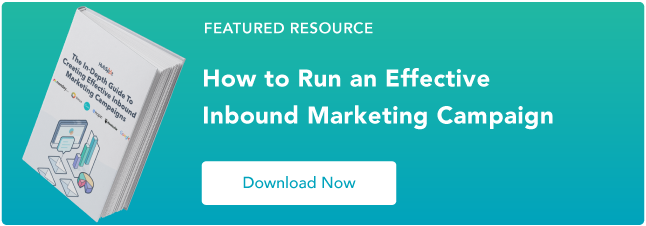Your audience no longer wants you to buy their attention — they want you to earn it.
This means lead generation strategies need to be revamped across the industry to better meet the needs of target markets.
The first step in this evolution is to create compelling content, and the second is to use that content to convert visitors into leads. Of course, this is easier said than done.Learn how to run more impactful, measurable marketing campaigns.
To highlight the importance of a powerful lead generation strategy, we are going to backtrack a little bit first.
Are you familiar with the analogy of the professor who presented his class with the challenge of trying to fit rocks, pebbles, sand, and water into a jar as efficiently as possible?
By prioritizing the biggest items and placing them in the jar first, he was able to optimize the amount of space used. Your business should take a similar mindset when implementing today's lead generation tactics into your inbound marketing strategy.
The Rocks, Pebbles, and Sand of Inbound Marketing
Like the professor who challenged his class to neatly fit rocks, pebbles, and sand into a jar, your inbound marketing strategy consists of rocks, pebbles, and sand. Here's what I mean by this:
- What are the large rocks that are the most essential to your strategy?
- What are the pebbles that serve as secondary, supportive tools for your business?
- What small stuff or distractions are the sand of your business?
Most businesses would argue that their customers are their "rocks", but I have another approach.
While it's indisputable to say that customers are essential to any business, I want you to instead think of them as the water that was used to finally fill the jar. The water was poured in only after everything else was firmly compacted in the jar.
Your business can benefit from taking this same mindset in your inbound marketing strategy.
The 4 L's of a Lead Generation Strategy
Your content is your rocks. Fill your jar first with content, as compelling content plays a huge role in generating leads. This includes the tools used to generate traffic, such as your blog, SEO, PPC, and social platforms.
Approximately 96% of business-to-business customers want content from industry thought leaders to inform their buying decisions. Creating compelling content is your key to establishing yourself as that go-to, educational leader in your industry.
You know what they say: you can catch a lot of flies with honey, but you can catch more honeys being fly. Try that cliche in a bar and it might end with a drink thrown in your face, but adapting that mindset in your inbound marketing strategy could not only improve lead generation rates but also increase the number of qualified leads your business attracts.
So, we've got our rocks — our content — in place. This article will focus primarily on the step that comes after that step — your pebbles, or the best practices for generating leads using your content.
You will quickly understand how companies that are hopping aboard the content train are generating 67% more leads per month than those who don't. Let's unpack the four L's of lead generation.
1. Lead Capture
Odds are that about half of your visitors will never return to your site if you do not adequately capture some bit of information from them. A working email address is the best thing a marketer can ask for here, but visitors are not always willing to give this kind of personal information up. Call-to-action (CTA) buttons like "Sign Up Here" have practically become synonymous with "We are Going to Spam You", which is why marketers need to find new ways to obtain this information.
Nicholas Kusmich, a Strategic Marketing Consultant and Facebook Ads Specialist, suggests a new rule of thumb for obtaining visitors' information. Kusmich suggests 2 golden rules be taken into account:
- We must give before we ask.
- Every step of the marketing process (advertisements and promotions) must be valuable in and of itself.
Kusmich goes more in-depth with these concepts in his article, "2 Golden Rules for The New Era of Marketing," but for now let's focus on that first rule.
Can you believe there was once a time, many years ago, where the opt-in email box was practically a luxury? It meant all the information you wanted would be delivered right to the comfort of your home. "What a time to be alive," we all thought. That day is now long gone. We now find ourselves fending off information from all angles.
Somewhere between installing pop-up blockers and dumping our spam folders, we made an oath to never "Sign Up Here" again. It's time marketers start gradually breaking down those walls that potential buyers have put up, by using new, mutually-beneficial opt-in methods to acquire their information. The best marketing method for this technique of "giving before we ask" includes using lead magnets.
2. Lead Magnets
A successful client lifecycle requires optimizing the process for converting visitors into leads. Unfortunately, a hole exists between the traffic generation phase and the lead generation phase that often results in one-time visitors who neglect your attempts to capture their information and never hear from you again.
You can seal up that hole with lead magnets. Lead magnets are tools that provide value for your visitors in exchange for their contact information. Businesses use lead magnets such as email opt-ins, subscriptions, and social media follows to fish for some sign of interest from their site's visitors.
The goal of this is to receive permission from visitors to follow up. Some examples of lead magnets include free:
- Training video series
- Free trial
- Webinars
- eBooks
- White papers
- A set of bonus tips
- An interview with an expert on a relevant topic
These free-of-charge educational tools will confide your visitors in your offering, allowing you to both obtain their email address and educate them on your business.
Whichever elements you use as lead magnets should be outlined in your marketing plan, as well as any goals, budget, or timelines for the creation of these marketing assets.
Download the Free Marketing Plan Template
3. Landing Page Conversion Techniques
Another huge asset to your business when trying to convert visitors into leads are landing pages. This can be any page that someone lands on after clicking on an advertisement or other online marketing elements. It is also important to note that landing pages exist separately from your company's website, and typically are used as a tool for a single marketing campaign.
A free, basic course on creating successful landing pages can be found on thelandingpagecourse.com. You can also learn lots of landing page tips and best practices from HubSpot's existing blog posts on landing pages.
For a quick video overview on the HubSpot Blog's expert lead generation tips, check out our video guide.
We will go over some of the basics of effective landing page design right now, but definitely check out those resources later on for a more in-depth breakdown of the different components involved.
Landing pages serve the dual purpose of capturing leads and warming up potential customers. Both of these are essential stepping-stones before moving a customer further down your sales funnel. Additionally, there are two types of landing pages:
Lead generation landing pages are used to capture a user/company's information in exchange for something. This relates back to the concept discussed earlier, of "giving before we ask."
Click-through landing pages are used to attract the visitor to the specific product or service that you are trying to sell. The goal is to educate your visitor with enough information that they proceed to make a purchase.
Landing pages have one call-to-action in mind. Instead of overwhelming visitors with information regarding your business and all the products and services you offer, it is essential that you narrow the focus down to one specific goal in mind. Be sure to cut out any excess information that isn't essential to the campaign, and be sure to include only one form or CTA link for them to utilize.
The most important element of your landing page is that it delivers the promise that your ad source made. If your ad says "Get 50% off computers here," you need to reassure the visitor as soon as possible on your landing page that you will deliver that.
One way to do this is to make the CTA on your ad source the headline on your landing page. Another way is to make sure the font, coloring, and images used in your ad are duplicated on your landing page to some degree.
4. Lead Scoring
Lead scoring is a component of marketing automation software that helps prioritize your leads according to their levels of engagement with your inbound marketing content and ultimately help you figure out who is ready to buy. It can also help you identify what they are interested in if setup correctly.
This technique is used to quantify interactions that prospects have with your content by assigning points for different types of engagement. An example of the different types of engagements and their point values might look like this:
- Download an ebook: Add 5 points
- Watch a product overview video: Add 7 points
- Job role not a good match: Deduct 10 points
- Fill out opt-in form: Add 7 points
- Unsubscribe from a list: Deduct 7 points
Surprisingly enough, 79% of B2B marketers have not established a lead scoring strategy. Lead scoring provides your company with real-time feedback on how responsive your leads are to your marketing efforts. It can also indicate people who are ready to buy from you, but haven't yet been in contact with you.
This point-based approach to recognizing and analyzing a company's hottest leads will save your business time and money when reaching your target market and capitalizing on sales opportunities. With your hottest leads identified, your business can communicate with these leads confidently knowing that they are already aware of and interested in your business.
Lead generation plays a role in every business's marketing strategy. Think about how many business sites you have visited since the dawn of the internet that you will never return to again. Not only did those businesses fail to capture your attention at that given time, but they failed to reconnect with you in the future.
This is a result of neglecting the lesson discussed in the jar analogy — prioritizing the different elements of your marketing strategy so that a foundation is in place for you to build an efficient and effective approach around.
With your content in place, your business can begin using lead magnets, lead capture, effective landing page design, and lead scoring to optimize lead generation rates and create an overall better-performing inbound marketing strategy.
Editor's note: This post was originally published May 2018 and has been updated for comprehensiveness.
.png?width=112&height=112&name=cover-how-to-run-inbound-marketing-campaign%20(1).png)








![Lead Generation Content: Top Types to Use in 2023 [Data + Expert Tips]](https://www.hubspot.com/hubfs/lead%20generation%20content.webp)
![Why You Still Need SMS Marketing & How to Get Started [+Data]](https://www.hubspot.com/hubfs/Why-you-need-sms-marketing.webp)
![Gated Content: What Marketers Need to Know [+Examples]](https://www.hubspot.com/hubfs/UNGated%20Content.png)

![What Is Demand Generation? [FAQs]](https://www.hubspot.com/hubfs/what-is-demand-generation.jpeg)